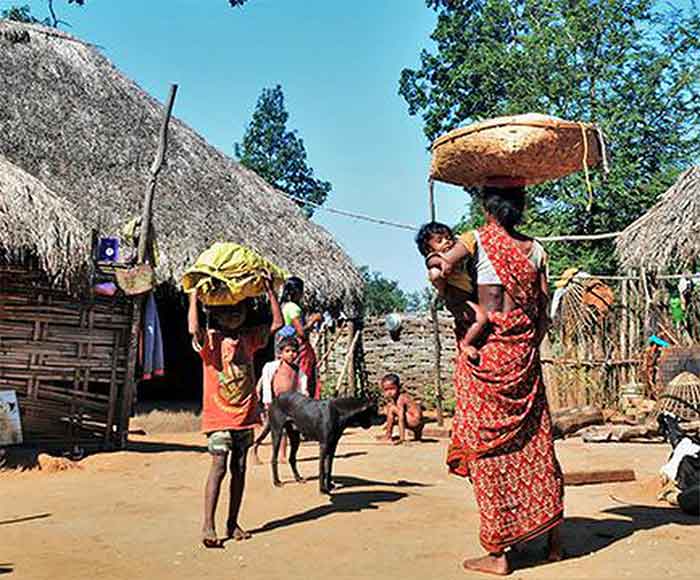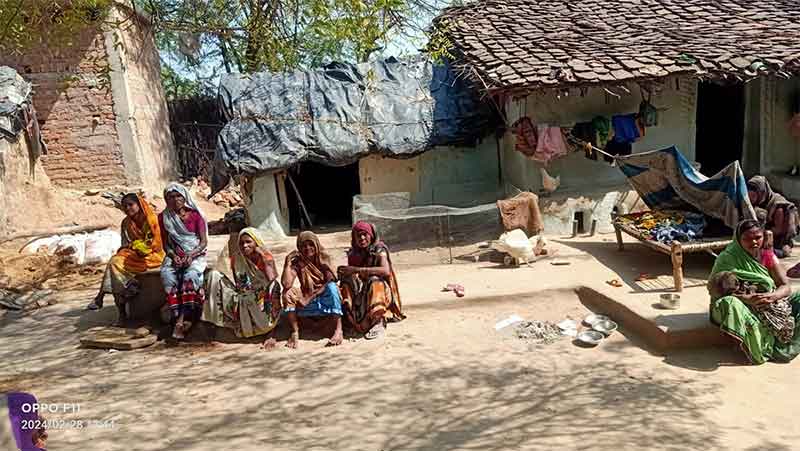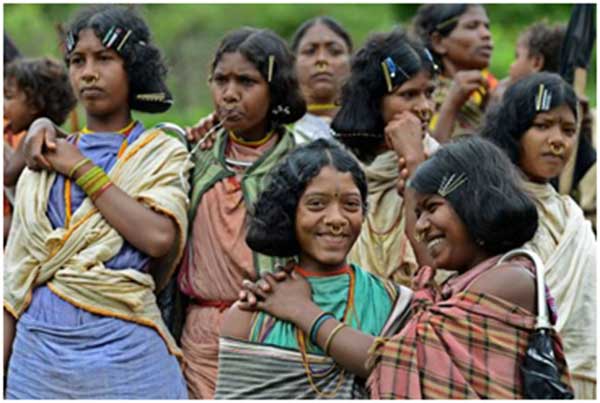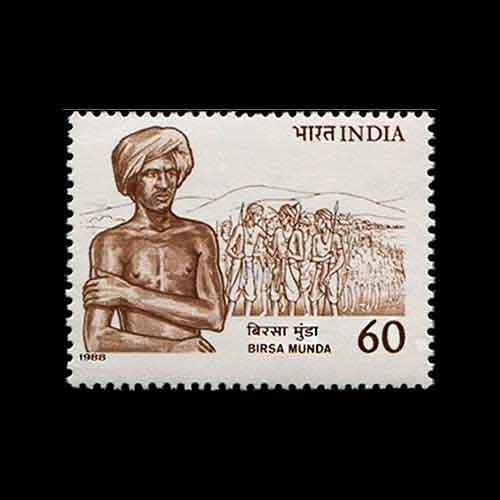
To
Smt Droupadi Murmu
President of India
Rashtrapati Bhawan
Subject:- Migrant Gutti Koyas (Murias) in Telangana facing a humanitarian crisis- Urgent need for recognition of their Constitutional rights in Telangana, AP, Odisha and Maharashtra
Respected Rashtrapati Ji,
A severe conflict situation in Chhattisgarh State since 2005-06 has forced more than 50,000 Muria adivasis, recognised as a Scheduled Tribe (ST) in their parent State, to migrate to the neighbouring States of Andhra Pradesh (AP), Telangana, Odisha and Maharashtra.
According to a rough assessment, there are about 240-250 settlements of the Murias, known locally as “Gutti Koyas”, largely in Mulugu and Bhadradri-Kothagudem districts of Telangana and to a limited extent in East and West Godavari districts of AP. Though, according to reports, the National Commission for the Scheduled Tribes (NCST), a Constitutional authority set up under Article 338A of the Constitution, had asked both Chhattisgarh and the other concerned States some time ago to undertake a more accurate identification and survey of the migrant Gutti Koyas, such a survey is yet to materialise.
Forcibly displaced from their parent State of Chhattisgarh, the Muria migrant families are not recognised as an ST in Telangana, AP, Odisha and Maharashtra. Consequently, they no longer enjoy the Constitutional rights due to them under the Fifth Schedule and under the special laws applicable to the Scheduled Areas, such as the Panchayats (Extension to the Scheduled Areas) Act of 1996 [PESA] and the Scheduled Tribes And Other Traditional Forest Dwellers (Recognition Of Forest Rights) Act, 2006 [Forest Rights Act or FRA], and the other legal entitlements that would have accrued to them.
The Gutti Koyas, who left their habitats in Chhattisgarh under duress, were desperate to find a place to settle down in Telangana and the other neighbouring States. Without anywhere else to go, they were forced to take shelter in forest areas and take up cultivation in small plots, where the local forest officials would treat them as “encroachers” and subject them to a constant threat of eviction. The provisions of the FRA do not apply to them, as their entry into Telangana and the other States was subsequent to the enactment of the FRA in 2006. Had they continued to stay in Chhattisgarh, they would have acquired occupation rights in forest areas under the FRA. The PESA and the FRA empower the adivasi Gram Sabhas in the Scheduled Areas to take decisions on projects and on the adivasis’ occupation rights in forests. The Gutti Koyas, living in isolated settlements in forest areas, are not considered a part of the Gram Sabhas. Thus, their forced migration to the neighbouring States has put them in a helpless situation of misery and trauma.
Though the Telangana and the AP governments did provide them ration cards, Aadhar cards, healthcare facilities and MGNREGA benefits, since they are not recognised as an ST, they had no access to many other benefits due to the STs. For example, they and their children did not have access to reservations in employment. The continuing conflict between them and the local forest officials has occasionally culminated in acts of violence. A few such instances have led the local officials to blame the entire Gutti Koya community as “criminals”. A local Gram Panchayat recently passed a resolution to evict them and send them back to Chhattisgarh. The Hon’ble Telangana High Court had intervened and kept the resolution in abeyance.
There are more than 6 lakhs of Koyas in AP and Telangana taken together and another 1.5 lakhs in Odisha. The population of Koyas in Maharashtra may be much less. Koyas, Gonds and Murias are ethnically one and the same, spreading across AP, Telangana, Maharashtra, Chhattisgarh and Odisha. Though they are geographically divided by inter-State borders, they have historically and culturally remained a part of the larger seamless Gond community.
A well-known anthropologist, Christoph von Fürer-Haimendorf, lived among the adivasis in these parts during the forties, earned their trust and documented their ethnicity and culture in detail. In his words, “the Koyas, a tribal population largely, though not exclusively, concentrated in (erstwhile) Andhra Pradesh, are the southernmost section of the great Gond race. Known also as Dorla Koitur, they merge on the southern border of Bastar with the Bisonhorn Marias, and some groups of Koyas, notably those in the lower Godavari regions, also possess bisonhorn head-dresses” (Tribes of India: The Struggle for Survival),
Whatever name by which they are described in the four different States of Telangana, AP, Maharashtra and Odisha, the Koyas, the Muriyas and the Gonds need to be viewed as a single ethnic entity and given the same status under the Constitution, irrespective of where they reside. Artificially drawn inter-State borders should not be permitted to strip them of their Constitutional rights.
In the Fifth Schedule areas, the provisions of the PESA and the FRA that recognise the primacy of the Gram Sabhas in decision making, are often wantonly ignored by the Centre and the States. In the matter of enforcement of the FRA, it is not the Gram Sabhas but the State Forest Departments that have been allowed to have an upper hand. This has often given rise to avoidable conflicts between the State administration and the adivasis. The situation is likely to worsen as a result of the hasty manner in which the Union Ministry of Environment recently amended the Forest Conservation Rules, ignoring the dissenting view expressed by the NCST.
In the particular case of Gutti Koyas outside Chhattisgarh, the problems have got compounded further by the fact that they no longer enjoy their status as an ST.
As things stand today, the Gutti Koyas, particularly in Telangana, are facing a serious existential crisis, as many non-tribals and some local officials have stepped up their demand that the Chhattisgarh government should take them back. It is doubtful whether this is feasible at this stage, when the Gutti Koyas have been away from their original habitats for more than a decade. The only alternative that is available today is to recognise the migrant Gutti Koyas as an ST in Telangana and the other three States and rehabilitate them in a humane manner.
It is relevant to mention here that several researchers have recently studied the problems of the migrant Gutti Koyas and documented the same. To the best of my knowledge, the most comprehensive among them is a study carried out by Smt. Dansari Anasuya, a sitting Koya legislator representing the Mulug constituency of the Telangana Legislative Assembly, as a part of her Ph D desertation. I understand that she had visited many Gutti Koya settlements extensively during the last few years and provided outstanding relief to several Gutti Koya families in need. She is perhaps the best person to be consulted on the plight of the Gutti Koyas in Telangana.
As things stand today, the Gutti Koyas are faced with a serious humanitarian crisis that needs to be understood and addressed forthwith. In this connection, I would earnestly appeal to you to intervene to provide a lasting solution to the problems faced by the Gutti Koyas in Telangana, AP, Odisha and Maharashtra.
I have the following proposal.
- As long as the migrant Gutti Koyas are not recognised as an ST, they will continue to face serious problems. Considering the fact that they are already an ST in Chhattisgarh and keeping in view their ethnic identity with the larger Gond community, they need to be recognised as an ST in Telangana, AP, Odisha and Maharashtra. Article 342(1) of the Constitution empowers the President, after consultation with the Governor of the concerned State, to issue a public notification, specifying the Gutti Koyas as an ST in relation to each of the four States. There have been numerous precedents to this. Article 342(1) and the Fifth Schedule not only empower the President in this regard but also require the President and the Governor to exercise oversight on tribal administration in the States. The Chhattisgarh government should simulataneously take counterveiling measures on its side to ensure that adequate confidence building measures are taken to ensure that the Murias are no longer under duress to migrate to the neighbouring States.
- While Section 3(1)(m) of the FRA of 2006 does refer to the plight of forcibly displaced forest dwellers and provides relief, it cannot not help the Gutti Koyas, as they had migrated after 2005. The FRA can however be suitably amended as a special case to provide a way out of this. Para 5 of the Fifth Schedule empowers the Governor of a State to, “by public notification, direct that any particular Act of Parliament or of the Legislature of the State shall not apply to a Scheduled Area or any part thereof in the State or shall apply to a Scheduled Area or any part thereof in the State subject to such exceptions and modificationsas he may specify in the notification and any direction given under this sub-paragraph may be given so as to have retrospective effect”. In other words, It is legally permissible under this provision for the Governor of the State to adapt the provisions of the FRA to permit the Gutti Koyas to be entitled to both individual and community pattas in respect of the forest areas they have occupied and have become dependent upon, on a justifiable assumption that they would have been eligible, had they not moved out of Chhattisgarh.
- In all these matters, the office of the President may elicit the considered view of the NCST, as required in Article 338A(9), before taking any further action.
- It is necessary for the Centre, the Chattisgarh government and the governments of Telangana, AP, Odisha and Maharashtra to undertake a comprehensive rehabilitation programme for the Gutti Koyas. Such a programme should focus on their livelihoods, their shelter needs, their healthcare and so on. Many Gutti Koya children are subject to ailments arising from malnutrition and they need to be treated urgently.
- For such a rehabilitation programme to be meaningful and comprehensive, a professional institution (for example, the Registrar General of Census) should be commissioned to conduct an accurate survey of the Gutti Koyas in the four States.
- The Union Ministry of Tribal Affairs and the State Tribal Welfare Departments should have special cells to monitor implementation of the rehabilitation programme.
- The Centre and the States should ensure that the Tribes Advisory Councils (TACs) set up under the Fifth Schedule become active in monitoring the rehabilitation programme for the Gutti Koyas.
- Article 275(1) of the Constitution empowers the Centre to release grants to a State “for promoting the welfare of the Scheduled Tribes in that State or raising the level of administration of the Scheduled Areas therein to that of the administration of the rest of the areas of that State” The Centre may, in consultation with the NCST and the Union Ministry of Tribal Affairs, quantify the financial assistance needed for rehabilitating the Gutti Koyas in the four States and release grants, depending on the extent of rehabilitation needed in each State.
- Under Article 275(1), the Centre may also release grants to the States to take up a comprehensive programme of reaching out to the adivasi Gram Sabhas and familiarising them with the implications of the PESA, the FRA and the other laws that benefit them, the ambit and the implications of the Tribal Sub-Plans etc., so as to ensure that the Gram Sabhas become active partners in tribal development.
- The Forest Conservation Rules, as amended recently by the Union Ministry of Environment, need to be revisited in the light of the observations made in that regard by the NCST. This is necessary to build confidence among the adivasis
I had earlier addressed you a letter (https://countercurrents.org/2022/07/president-should-play-a-proactive-role-for-tribals/) on several other ameliorative measures aimed at promoting the welfare of the adivasis in the country. They continue to have relevance in the present context.
I earnestly believe that such confidence building measures are urgently needed for providing relief to the adivasis in general and the migrant Gutti Koyas in particular. I feel that it is equally necessary to tone up administration in the Scheduled Areas of the country, keeping in view the sensitive nature of the problems faced by the adivasis there.
Respectfully,
E A S Sarma, Former Commissioner (Tribal Welfare), Govt of Andhra Pradesh (AP) & Former Secretary to Government of India

















































